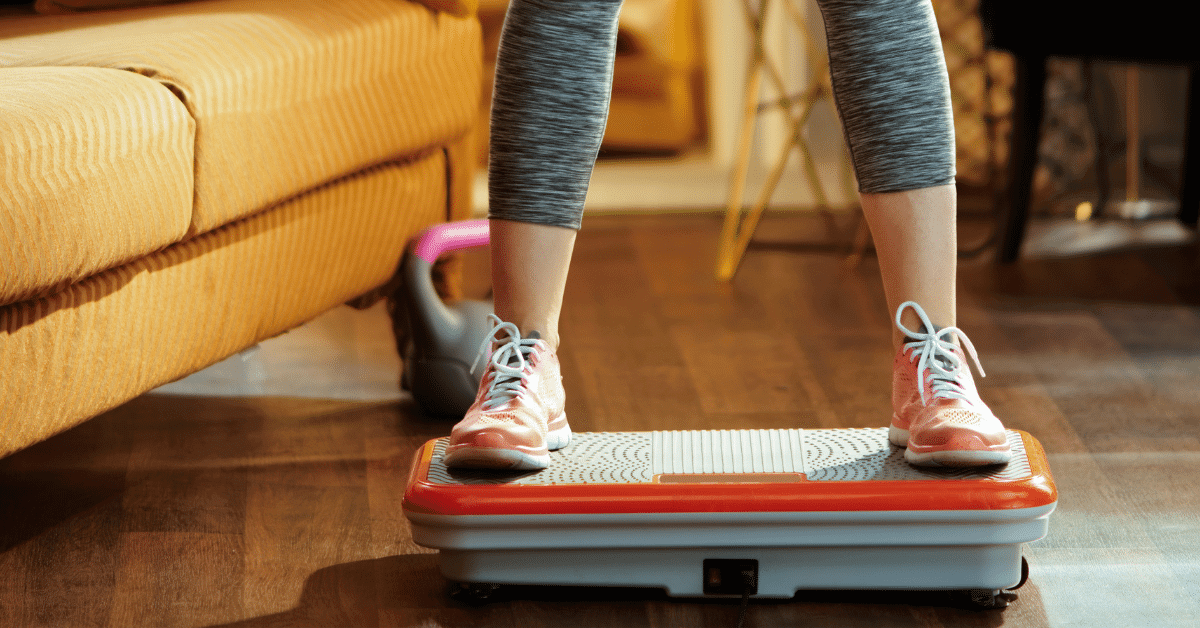Stress, anxiety, worry—in our busy modern lives, these seem to be universal experiences that can seriously impact our health and happiness. However, many proven techniques are available to help you better manage symptoms and regain a sense of inner calm.
One complementary approach that has been gaining interest in recent years is vibration therapy 1. Keep reading to learn what it is, how it works, its benefits and risks, and whether it may be worth exploring for your situation.
What are the health benefits of vibration therapy?
Vibration therapy benefits include improved muscle strength, increased circulation, enhanced bone density, and stress relief. It’s used for rehabilitation and fitness, helping with conditions like muscle soreness and Parkinson’s disease. The therapy works by causing muscles to contract through high-frequency vibrations, aiding recovery and health.
This blog is part of a series on “relaxation techniques.“
Key Aspects of Vibration Therapy for Health and Fitness
- Enhanced Muscle Recovery: Accelerates the reduction of muscle soreness after workouts.
- Increased Bone Density: Useful in preventing conditions like osteoporosis through regular use.
- Improved Circulation: Promotes better blood flow, enhancing overall health and wellness.
- Stress Reduction: Offers significant mental health benefits by reducing symptoms of stress and anxiety.
- Weight Management: Assists in burning calories and fat, proving effective alongside a healthy diet.
- Pain Management: Helps alleviate chronic pain, including back pain, through consistent therapy sessions.
- Accessibility: Provides a low-impact exercise option suitable for individuals with mobility limitations.
Benefits of Vibration Therapy for Muscle Soreness and Recovery
Vibration therapy helps alleviate muscle soreness and accelerate recovery. This type of therapy uses high-frequency vibrations to reduce the pain of delayed-onset muscle soreness. The vibrations help muscles contract and relax more effectively, promoting faster healing. Vibration therapy can be particularly beneficial after intense exercise, reducing the next-day soreness that many experience.
The soothing effects of vibration help increase blood flow to stressed muscle groups. Increased blood flow delivers more oxygen and nutrients, crucial for muscle repair. This not only speeds up recovery times but also improves overall muscle health. Regular vibration therapy can help athletes and fitness enthusiasts prepare their bodies for the next workout sooner.

Vibration therapy uses a vibrating platform to engage the whole body or specific parts, depending on the need. This approach makes it versatile for treating muscle soreness in different areas. The effectiveness of vibration therapy in promoting muscle recovery has made it a popular choice in rehabilitation centers and home fitness setups.
Overall, various studies support the benefits of vibration therapy in treating muscle soreness, highlighting its ability to enhance muscle recovery and maintain muscle health over time.
Whole-Body Vibration: Applications and Advantages
Whole-body vibration therapy involves standing, sitting, or lying on a machine with a vibrating platform. This vibration stimulates the entire body, which can have various health benefits. For instance, it has been shown to improve muscle strength and increase bone mineral density, making it a valuable tool for preventing osteoporosis.
The therapy is often used in rehabilitation settings to help patients recover from injuries or manage chronic conditions. The vibrations activate muscle fibers, leading to improved muscle tone and circulation. This is especially beneficial for those unable to perform conventional exercise due to pain or mobility limitations.
| Type of Vibration Therapy | Muscle Health | Bone Health | Mental Health | Weight Management |
|---|---|---|---|---|
| Whole-Body Vibration | Improves muscle strength and recovery | Increases bone mineral density | Reduces symptoms of anxiety and stress | Enhances calorie burn and fat loss |
| Localized Vibration Therapy | Targets specific muscle groups for relief | Less impact on bone health | Calming effect on localized areas | Minor impact on overall weight |
In addition to physical benefits, whole-body vibration can help reduce back pain and improve joint health. The vibrations help reduce stiffness and increase range of motion, relieving discomfort and enhancing overall quality of life. As it requires minimal effort and is low impact, whole-body vibration is suitable for many individuals, including the elderly and those with certain disabilities.
Furthermore, whole-body vibration training is a time-efficient way to stimulate and strengthen muscles, making it an attractive option for those looking to improve their fitness but have limited time to dedicate to traditional exercise methods.
Vibration Therapy’s Role in Improving Mental Health
Vibration therapy benefits physical health and contributes positively to mental health. The gentle, rhythmic vibrations can have a calming effect on the nervous system, helping to reduce symptoms of anxiety and stress. This makes vibration therapy an excellent complement to traditional mental health treatments.
The stimulation from vibration can increase the release of endorphins, the body’s natural painkillers and mood enhancers. This biochemical boost can lead to improved feelings of well-being and decreased feelings of depression. Vibration therapy provides a unique, physical way to influence mental health positively.
For those dealing with chronic pain, which often carries mental health burdens like anxiety and depression, vibration therapy offers a dual benefit. It helps manage the physical aspects of pain while also contributing to a more positive mental outlook by reducing the psychological stress associated with long-term pain management.
Incorporating vibration therapy into a holistic approach to health care can enhance physical and mental well-being, making it a versatile therapy option in the healthcare industry.
Vagus Nerve Stimulation: A Novel Vibration Therapy Option
Vagus nerve stimulation (VNS) represents an innovative addition to vibration therapy techniques, focusing on enhancing mental well-being and managing stress. By delivering gentle impulses to the vagus nerve, which is crucial for regulating mood and relaxation, VNS devices can significantly augment the therapeutic effects of traditional vibration therapy.
Incorporating VNS devices into your vibration therapy regimen can enhance the calming effects, aid in stress reduction, and potentially improve symptoms of depression and anxiety.
Personal Thoughts
In my own experience with chronic stress, I found vibration therapy to be a welcome addition to my stress management routine. It gave me a sense of calm and reduced my day-to-day tension significantly.
Adopting this method helped me better manage stress reactions and regain a much-needed balance in my life. I recommend trying vibration therapy as part of a holistic approach to handling stress and improving overall health.
Frequently Asked Questions
How does vibration therapy enhance muscle and bone health?
Vibration therapy stimulates muscles and bones through high-frequency vibrations, enhancing muscle strength and mineral density. This can be particularly beneficial in preventing osteoporosis and aiding muscle recovery, making it a valuable tool for rehabilitation and fitness routines.
What are the proven benefits of vibration therapy?
Research suggests that vibration therapy helps improve circulation, muscle strength, and flexibility. It has been used effectively to reduce pain, speed up muscle recovery, and enhance bone health. Studies in controlled environments have consistently demonstrated these health benefits, making it a trusted method in physical therapy.
Can vibration therapy help with weight loss and fitness?
Vibration therapy can aid in weight loss by increasing muscle activation, which boosts metabolism and burns more calories. Regular sessions on a vibration plate can complement fitness routines by enhancing muscle tone and overall body strength, supporting weight management goals.
Is vibration therapy suitable for managing chronic pain?
Vibration therapy has been shown to reduce chronic pain, including severe back pain and muscle pain, by improving blood flow and muscle relaxation. It is often used in clinical settings to provide pain relief and improve the quality of life for those suffering from long-term pain conditions.
What should I consider before starting vibration therapy?
Before starting vibration therapy, it’s important to consult with a healthcare provider, especially if you have conditions like lumbar spine issues or severe osteoporosis. Consider the frequency and duration of therapy sessions, as excessive vibrations can be harmful. Ensure the therapy settings are tailored to your specific health needs.




